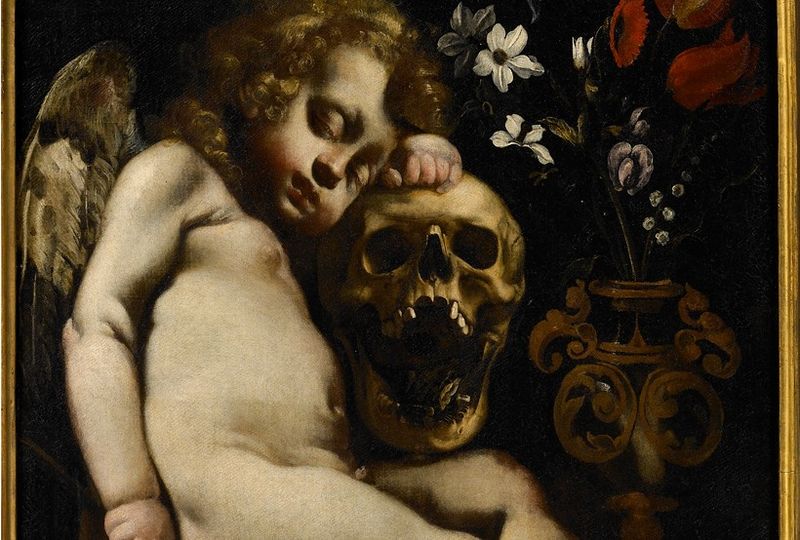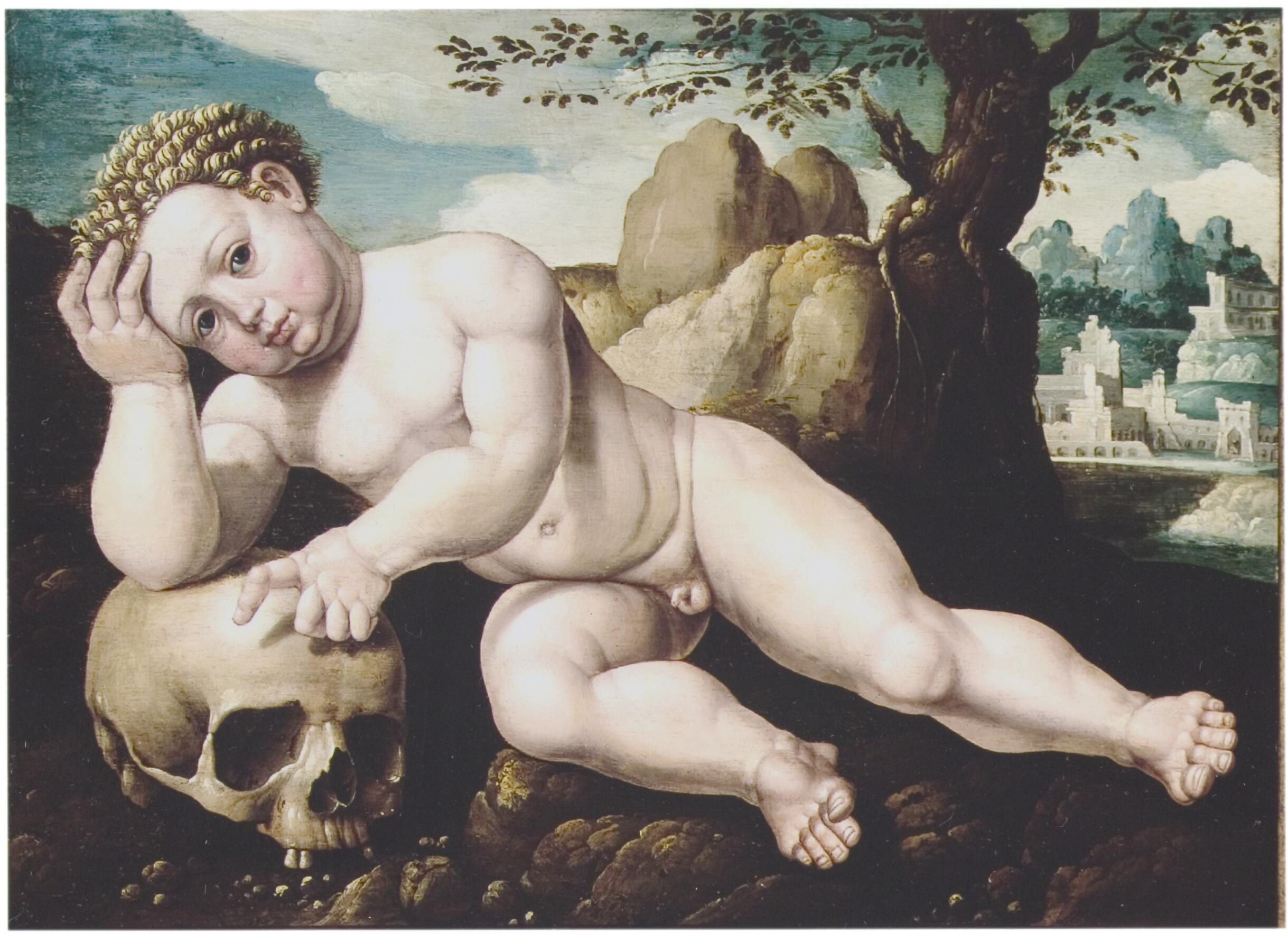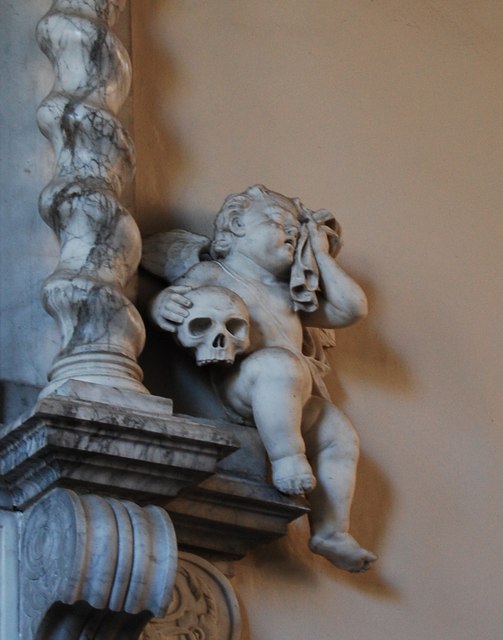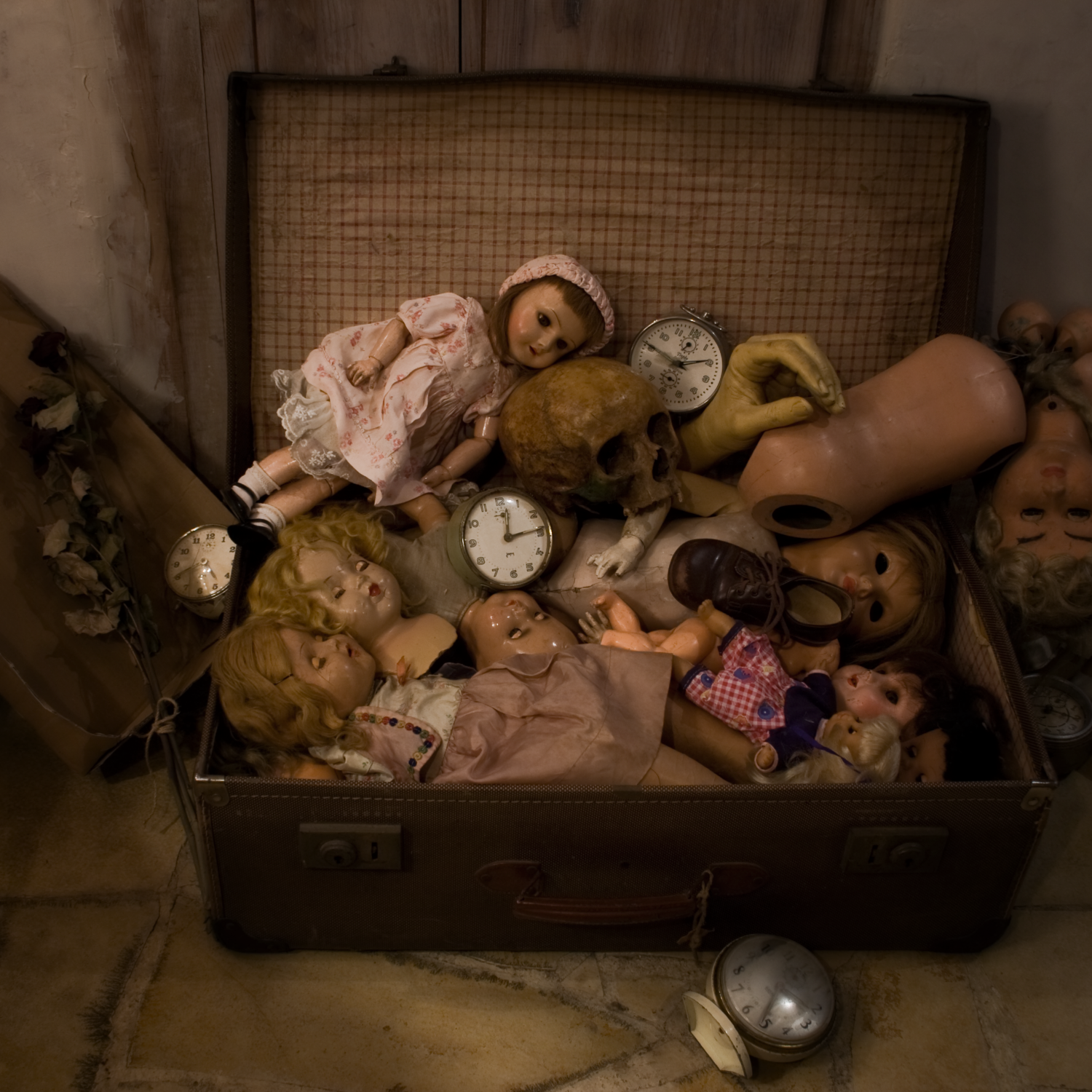Как родились- так и умрем. Младенцы с черепами.
Ванитас. Сюжет "Nascendo Morimur" 16-17 век.



"Nascendo Morimur” можно перевести такой фразой- как родились, так и умрем.
Этот сюжет был популярен в Германии и Фландрии в 16 веке. Обычно на картине изображался спящий младенец с черепом.
-----------Vanitas - Homo bulla--------------
Я показвала еще один популярный сюжет ванитас-"Homo bulla" с детьми и мыльными пузырями.
Сейчас их не воспринимают, как напоминание о смерти, смысл картин- жизнь, как мыльный пузырь- непонятен.

Vanitas - Homo bulla and apothecary accessories.
Polski: Vanitas - Homo bulla i akcesoria aptekarskie.
Date 1660

Karel van Sichem: Homo Bulla,
around 1617

Print made by Raphael Sadeler I
After Marten de Vos
1590 (c.)

Quis Evadet? (Who will be spared?)
Hendrik Goltzius
Vanitas; allegory of transience; a reclining putto blowing bubbles and leaning on a skull. 1594
---------Nascendo Morimur- графика-----------
==========================================

Mors omnia aequat' ('Death equalises all')
Print made by Barthel Beham
1528-1530 (circa)

Published by Hieronymus Cock
1550
Vanitas; a large skull and a sleeping putto

Child sleeping on a skull
Engraving made by Barthel Beham, 1525

Mother and a infant with a skull and hourglass
Engraving made by Barthel Beham, 1528-30
------Nascendo Morimur -скульптура-------

Le Temps, allégorie. Ivoire, hauteur environ 30 cm. - Musée du Louvre, vitrine des montres (pas de cartel).

German 17th century casket in carved ivory and semi-precious stones. Applied Arts Collections Museum in the Sforza Castle in Milan, Italy

--------Nascendo_morimur-живопись------------
=============================================
This type of painting is known as a "Nascendo Morimur”, which could be translated as ‘As we are born, we die”. This was a popular theme in Flanders and Germany during the 16th century.
--------------------------------

John the Baptist reclining on a skull in a classical landscape, known as genre "Nascendo Morimur".
Date
ca. 1540

Frans Floris - nascendo morimur 1550-79
-------------------------------

Painting of baby with skull.
Date
1540
-------------------------

Pieter Moninckx
Title
Français : L’Amour endormi sur un crâne
Date 17th century
---------------------

Bartholomäus Spranger, Nascendo morimur, after 1600. Oil. Wawel Castle, Krakow. Inscr. "HODIE MIHI, CRAS TIBI" - It's my lot today, yours tomorrow.
-------------------------

Luigi Miradori (dit Genovesino), Cupidon endormi, vers 1652, Museo civico Ala Ponzone, Cremona © Sistema Museale della Città di Cremona - Museo civico Ala Ponzone, Cremona

------------Живопись---------
=============================

Pieter Moninckx (circa 1606-circa 1686) L’Amour endormi sur un crâne
Date 17th century

Putto Sleeping on a skull
De Agostini Picture Library / G. Dagli Orti
Unknown French painter (17th century), Putto Sleeping on a Skull, copy after Genovesino (Luigi Miradori, ca. 1610-ca. 1654).
---------------------

An Allegory Of Vanitas, With A Putto, A Skull, An Hourglass And Flowers, The Resurrection Of Christ Beyond
By (after) Adriaen Van Nieulandt

DUTCH SCHOOL, 17 > (Netherlands)
'Vanitas': A putto playing with soap bubbles seated on a draped ledge with a skull, a lute, arms and a globe
Date : 1642/1660

Follower of Jan van Scorel
A young boy musing, with a skull in a landscape

Vanitas With A Putto Resting His Hand On A Skull
Bloemaert, Abraham
Dutch Artist, 1564 ~ 1651

Death of a putto (oil on canvas)
Title:
Crespi, Luigi (1709-79)
-------------Путти с черепами--------------
=======================================

Nicolas de Bruyn
Children’s Games. No. 6. (Two Putti withSkull)
1594

Landscape with a child seated on a skull at centre,
holding a mirror and a rose.
Another skull in lower right corner.
Engraving made by Augustin Jorisz, 1548-1560.

Jacob Hoefnagel
(1542 - 1601)
-------------скульптура-------
-----------Надгробия и эпитафии------------


Saint Michael parish church in Untergriesbach. Epitaph of parish priest Johann Georg Dietrich ( 1731 ) - Putto holding a skull as symbol of vanity.
---------

Uppsala domkyrka / Uppsala cathedral. Grave of Gustav Vasa and two of his wives; the inscription read: memorare novissima, et in aeternum non peccabis (the w:en:Vulgate's Latin rendering of Ecclesiasticus
-----------

Saint Mary Magdalene parish church in Oepping ( Upper Austria ). Statue of a putto ( 1695 ) holding symbols of vanity by Bartolomeo Carlone.
------------------------


Putto with Skull
Montparnasse cemetery in Paris.

A cherub, or probably a putto, in Christ's College chapel, Cambridge. I


Putto with Skull
On Memorial to Lady Joanna Thornhill (d.1708), Wye Church
------------------

In a old suitcase, a pile of antique dolls, a human skull, ancient alarm clocks and death roses, remind us that we are only temporary
Еще по теме:
========================


Ванитас."Нomo bulla" и мыльные пузыри-ТУТ



ВАНИТАС, все посты-ТУТ



"Nascendo Morimur” можно перевести такой фразой- как родились, так и умрем.
Этот сюжет был популярен в Германии и Фландрии в 16 веке. Обычно на картине изображался спящий младенец с черепом.
-----------Vanitas - Homo bulla--------------
Я показвала еще один популярный сюжет ванитас-"Homo bulla" с детьми и мыльными пузырями.
Сейчас их не воспринимают, как напоминание о смерти, смысл картин- жизнь, как мыльный пузырь- непонятен.

Vanitas - Homo bulla and apothecary accessories.
Polski: Vanitas - Homo bulla i akcesoria aptekarskie.
Date 1660

Karel van Sichem: Homo Bulla,
around 1617

Print made by Raphael Sadeler I
After Marten de Vos
1590 (c.)

Quis Evadet? (Who will be spared?)
Hendrik Goltzius
Vanitas; allegory of transience; a reclining putto blowing bubbles and leaning on a skull. 1594
---------Nascendo Morimur- графика-----------
==========================================

Mors omnia aequat' ('Death equalises all')
Print made by Barthel Beham
1528-1530 (circa)

Published by Hieronymus Cock
1550
Vanitas; a large skull and a sleeping putto

Child sleeping on a skull
Engraving made by Barthel Beham, 1525

Mother and a infant with a skull and hourglass
Engraving made by Barthel Beham, 1528-30
------Nascendo Morimur -скульптура-------

Le Temps, allégorie. Ivoire, hauteur environ 30 cm. - Musée du Louvre, vitrine des montres (pas de cartel).

German 17th century casket in carved ivory and semi-precious stones. Applied Arts Collections Museum in the Sforza Castle in Milan, Italy

--------Nascendo_morimur-живопись------------
=============================================
This type of painting is known as a "Nascendo Morimur”, which could be translated as ‘As we are born, we die”. This was a popular theme in Flanders and Germany during the 16th century.
--------------------------------

John the Baptist reclining on a skull in a classical landscape, known as genre "Nascendo Morimur".
Date
ca. 1540

Frans Floris - nascendo morimur 1550-79
-------------------------------

Painting of baby with skull.
Date
1540
-------------------------

Pieter Moninckx
Title
Français : L’Amour endormi sur un crâne
Date 17th century
---------------------

Bartholomäus Spranger, Nascendo morimur, after 1600. Oil. Wawel Castle, Krakow. Inscr. "HODIE MIHI, CRAS TIBI" - It's my lot today, yours tomorrow.
-------------------------

Luigi Miradori (dit Genovesino), Cupidon endormi, vers 1652, Museo civico Ala Ponzone, Cremona © Sistema Museale della Città di Cremona - Museo civico Ala Ponzone, Cremona

------------Живопись---------
=============================

Pieter Moninckx (circa 1606-circa 1686) L’Amour endormi sur un crâne
Date 17th century

Putto Sleeping on a skull
De Agostini Picture Library / G. Dagli Orti
Unknown French painter (17th century), Putto Sleeping on a Skull, copy after Genovesino (Luigi Miradori, ca. 1610-ca. 1654).
---------------------

An Allegory Of Vanitas, With A Putto, A Skull, An Hourglass And Flowers, The Resurrection Of Christ Beyond
By (after) Adriaen Van Nieulandt
DUTCH SCHOOL, 17 > (Netherlands)
'Vanitas': A putto playing with soap bubbles seated on a draped ledge with a skull, a lute, arms and a globe
Date : 1642/1660

Follower of Jan van Scorel
A young boy musing, with a skull in a landscape

Vanitas With A Putto Resting His Hand On A Skull
Bloemaert, Abraham
Dutch Artist, 1564 ~ 1651

Death of a putto (oil on canvas)
Title:
Crespi, Luigi (1709-79)
-------------Путти с черепами--------------
=======================================

Nicolas de Bruyn
Children’s Games. No. 6. (Two Putti withSkull)
1594

Landscape with a child seated on a skull at centre,
holding a mirror and a rose.
Another skull in lower right corner.
Engraving made by Augustin Jorisz, 1548-1560.

Jacob Hoefnagel
(1542 - 1601)
-------------скульптура-------
-----------Надгробия и эпитафии------------


Saint Michael parish church in Untergriesbach. Epitaph of parish priest Johann Georg Dietrich ( 1731 ) - Putto holding a skull as symbol of vanity.
---------

Uppsala domkyrka / Uppsala cathedral. Grave of Gustav Vasa and two of his wives; the inscription read: memorare novissima, et in aeternum non peccabis (the w:en:Vulgate's Latin rendering of Ecclesiasticus
-----------

Saint Mary Magdalene parish church in Oepping ( Upper Austria ). Statue of a putto ( 1695 ) holding symbols of vanity by Bartolomeo Carlone.
------------------------


Putto with Skull
Montparnasse cemetery in Paris.

A cherub, or probably a putto, in Christ's College chapel, Cambridge. I


Putto with Skull
On Memorial to Lady Joanna Thornhill (d.1708), Wye Church
------------------

In a old suitcase, a pile of antique dolls, a human skull, ancient alarm clocks and death roses, remind us that we are only temporary
Еще по теме:
========================


Ванитас."Нomo bulla" и мыльные пузыри-ТУТ


ВАНИТАС, все посты-ТУТ